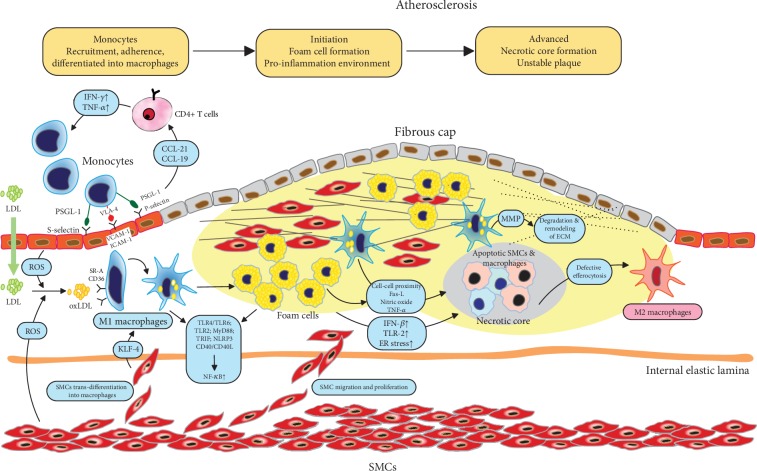Figure 1.
Roles of macrophages in different stages of atherosclerosis progression. Atherosclerosis is initiated by the subendothelial deposition of lipids. Circulating monocytes are recruited to the lesion site by adhering to activated endothelial cells (ECs) and entering the subendothelial cell space. Within the plaque, macrophages take up lipid deposit particles and transform into foam cells, forming early atherosclerotic lesions. Lesional macrophages further induce a cascade of inflammatory responses, promoting more lipoprotein retention, extracellular matrix (ECM) alteration, and sustained chronic inflammation. Oxidized LDL (oxLDL) further induces the necrosis of foam cells, which construct a necrotic core, leading to instability and rupture of advanced plaques. Abbreviations: CCL: chemokine ligand; ECM: extracellular matrix; ER: endoplasmic reticulum; Fas-L: Fas ligand; ICAM: intercellular adhesion molecule; IFN: interferon; IL: interleukin; KLF4: Kruppel-like factor 4; MMP: matrix metalloproteinase; NF-κB: nuclear factor of kappa B; NLRP3: leucine-rich repeat pyrin domain containing 3; oxLDL: oxidized low-density lipoprotein; PSGL-1: P-selectin glycoprotein ligand-1; ROS: reactive oxygen species; SMC: smooth muscle cells; SR-A: type A scavenger receptor; TLR: toll-like receptor; TNF: tumor necrosis factor; TRIF: toll-like receptor domain-containing adaptor; VCAM: vascular cell adhesion molecule; VLA-4: very-late antigen 4.

